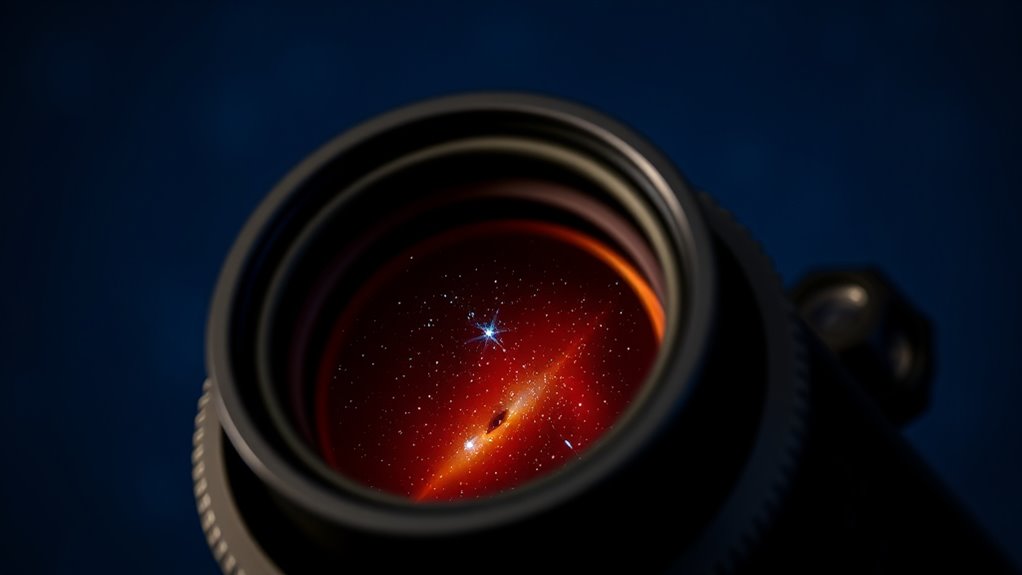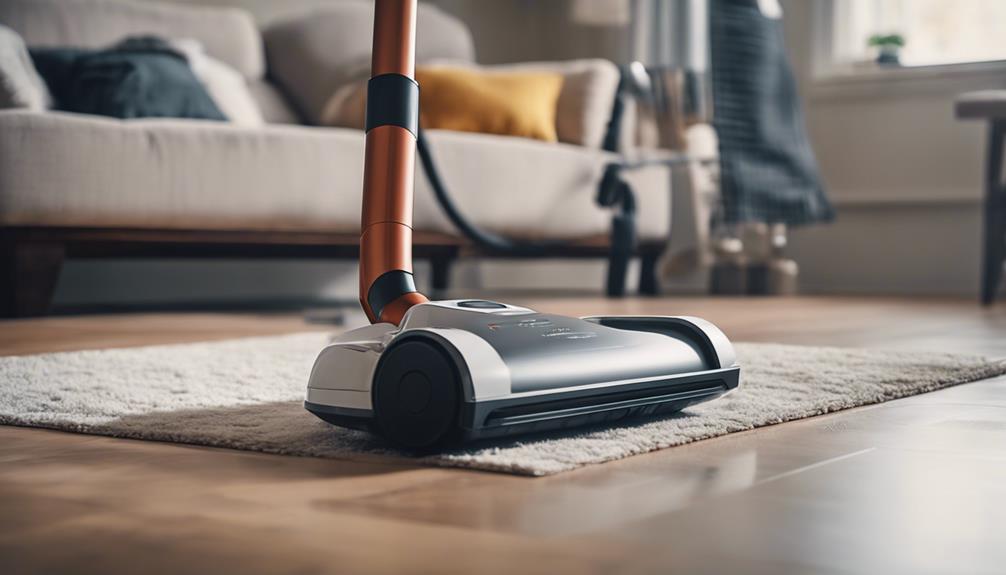If you’re looking for the best field flatteners for refractor telescopes, I’ve found top options that deliver crisp, edge-to-edge images. These include models like the SVBONY SV209 and SV503, Sky Watcher Evolux 62ED, and Explore Scientific flatteners, all designed to minimize distortion and improve your imaging quality. They’re suitable for various telescope models and support full-frame cameras. Keep exploring, and you’ll discover how these tools can transform your astrophotos.
Key Takeaways
- Field flatteners correct optical distortions, providing sharp, edge-to-edge images for refractor telescopes.
- They enhance image quality by minimizing star distortion and chromatic aberration across the entire field.
- Compatibility varies; select flatteners designed for specific focal ratios and telescope models.
- Features include multi-coated optics, adjustable spacing, and lightweight, durable construction.
- Ideal for astrophotographers aiming for crisp, high-contrast images of planets, nebulae, and galaxies.
SVBONY SV209 Field Flattener, 0.8X Focal Reducer for Telescopes
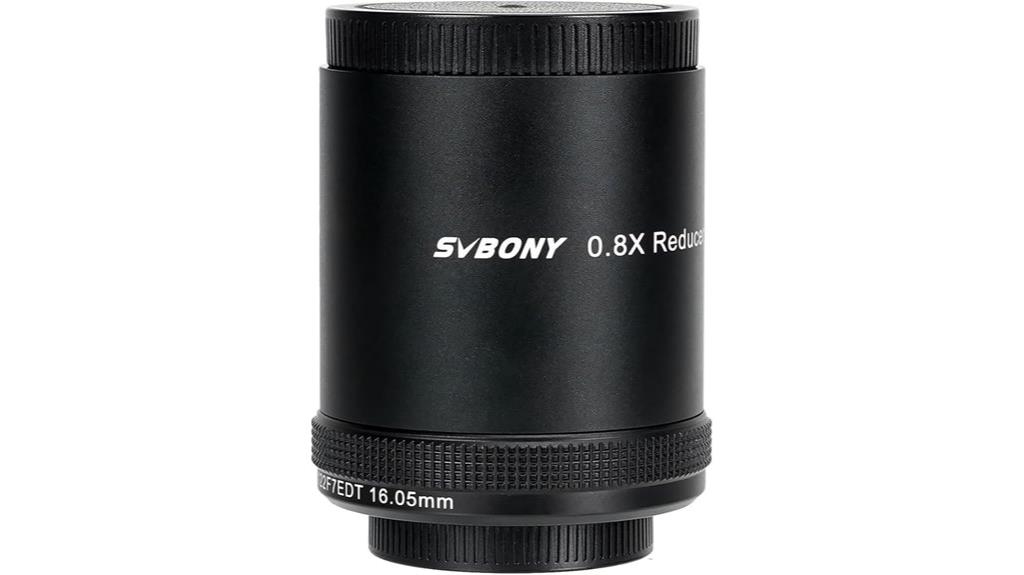
If you’re a photography enthusiast using a SV550 122mm APO refractor, the SVBONY SV209 Field Flattener is an excellent choice because it effectively corrects field curvature and widens your field of view. This 0.8X focal reducer reduces your focal length from 854mm to 683.2mm, transforming f/7 to f/5.6 for faster, broader imaging. It screws securely into your focuser with a 63×1 threaded connection, ensuring stability. By correcting edge distortion, it delivers sharper, more uniform images across your entire frame. Whether you’re into astrophotography or terrestrial photography, this flattener boosts image quality and shooting efficiency markedly.
Best For: astrophotographers and terrestrial photographers using the SV550 122mm APO refractor seeking improved image clarity, wider field of view, and faster imaging capabilities.
Pros:
- Effectively corrects field curvature for sharper images across the entire frame
- Reduces focal length from 854mm to 683.2mm, enabling faster, wider shots at f/5.6
- Secure 63×1 threaded connection ensures stable attachment and reliable performance
Cons:
- Designed specifically for SV550 122mm APO refractors, limiting compatibility with other telescopes
- May require additional adapters for use with different camera types or accessories
- Not suitable for use with telescopes that do not support 63×1 thread connections
SVBONY Focal Reducer and Field Flattener for SV503 102mm ED Telescope
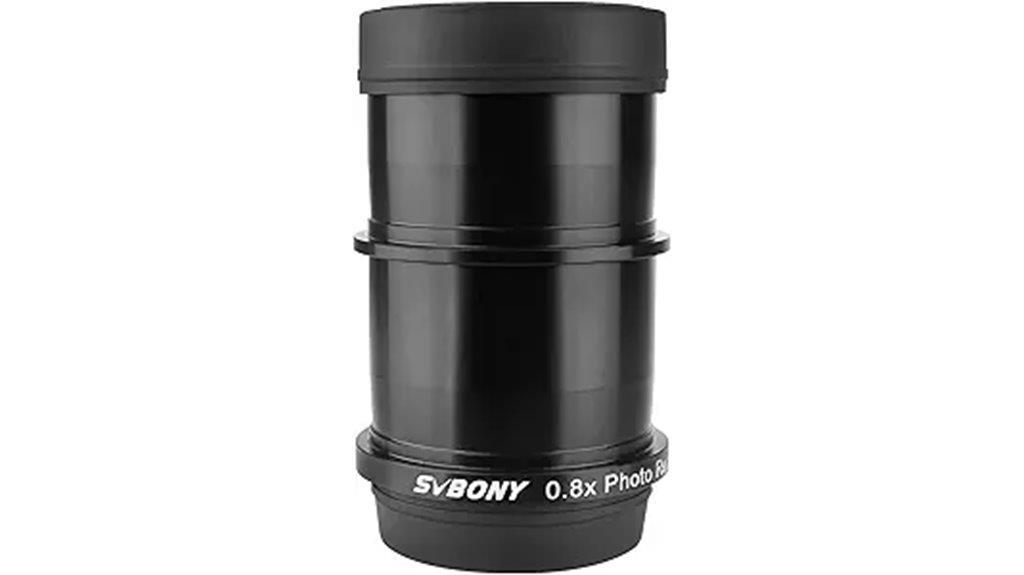
The SVBONY Focal Reducer and Field Flattener for the SV503 102mm ED Telescope stands out as an excellent choice for astrophotographers seeking crisp, wide-field images. It offers a 0.8x reduction, making it ideal for full-frame astrophotography. With multi-coated optics and a high-polish finish, it guarantees maximum light transmission and durability. It reduces focus distance, expands sky coverage, and produces finer star points without edge distortion. Compatibility with standard filters and threaded connections makes it versatile. Its lightweight, durable aluminum body is designed specifically for refractors, providing reliable, high-quality performance for both visual and imaging applications.
Best For: astrophotographers seeking high-quality, versatile focal reduction and field flattening solutions for full-frame imaging with their SV503 102mm ED refractor telescope.
Pros:
- Provides 0.8x reduction for wider sky coverage and improved imaging quality
- Multi-coated optics with high-polish finish ensure maximum light transmission and durability
- Compatible with standard filters and threaded connections for versatile setup options
Cons:
- Designed specifically for SV503 102mm ED telescopes, limiting universal compatibility
- Requires precise attachment to avoid potential alignment issues during setup
- Slight additional weight may affect balancing in very lightweight or portable setups
SVBONY SV503 Refractor Telescope with Built-in Field Flattener

For amateur astronomers seeking a streamlined imaging experience, the SVBONY SV503 Refractor Telescope with Built-in Field Flattener stands out thanks to its integrated flat-field correction. Its design eliminates field curvature, providing sharp, distortion-free images across the entire field of view. With a 70mm aperture and F/6.78 focal ratio, it delivers bright, detailed views of galaxies, nebulae, and star clusters. The use of ED glass reduces chromatic aberration, ensuring true-to-life colors. The self-flat-field feature allows quick setup without extra accessories, and the dual-speed focuser offers precise control. Built with durable CNC components, this telescope combines convenience, stability, and high optical performance.
Best For: amateur astronomers and astrophotographers seeking a user-friendly, high-performance telescope with integrated flat-field correction for sharp, wide-field imaging.
Pros:
- Built-in field flattener ensures distortion-free, sharp images across the entire field of view
- Durable CNC construction with high-quality ED glass for reduced aberrations and true-to-life colors
- Dual-speed focuser provides precise and seamless focusing for both visual and imaging applications
Cons:
- 70mm aperture may be limited for deep-sky object detail compared to larger telescopes
- Compatibility may require additional accessories for advanced astrophotography setups
- Slightly compact size might be less suitable for very high-magnification observations
Sky Watcher Evolux 62ED Reducer/Flattener (0.9X)
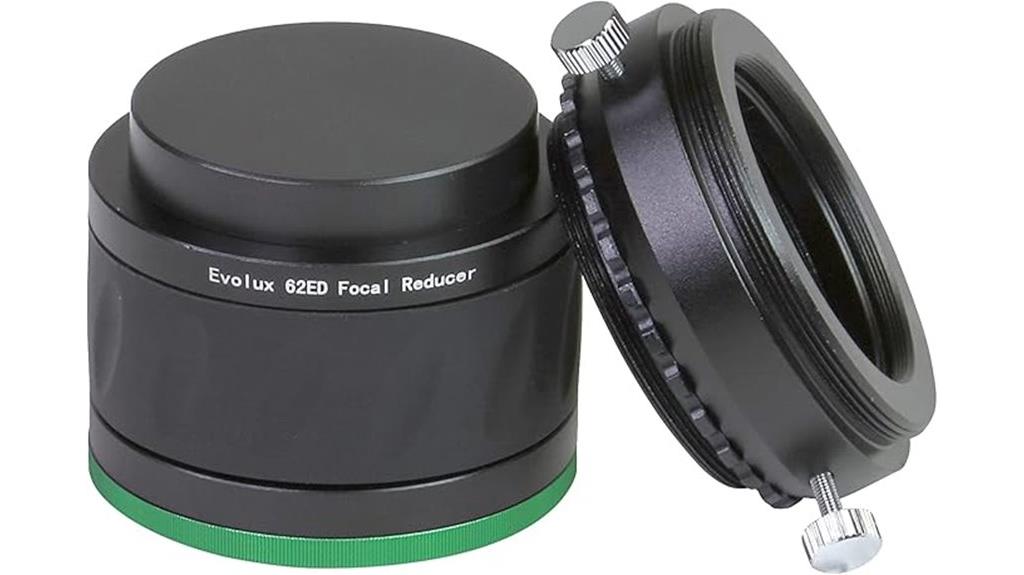
Astrophotographers seeking sharp, wide-field images will find the Sky Watcher Evolux 62ED Reducer/Flattener (0.9X) an excellent choice, especially when working with Evolux 62mm refractors. It features a 62mm aperture, f/5.8 focal ratio, and a 360mm focal length, optimized for flat field imaging. The reducer corrects field curvature, reduces exposure times by 24%, and guarantees edge-to-edge sharpness. Its compact, lightweight design (14 ounces) includes a rotator/adapter with built-in cavity for 2-inch filters. Threaded for M56x1 female and M48 male connections, it’s a versatile, reliable tool for achieving crisp, professional astrophotos.
Best For: astrophotographers using Evolux 62mm refractors seeking to achieve flat, sharp, wide-field images with reduced exposure times.
Pros:
- Produces a flat field across the entire image, minimizing field curvature and vignetting
- Reduces exposure time by 24%, enabling quicker imaging sessions
- Compact and lightweight design (14 ounces) with versatile threaded connections and built-in filter cavity
Cons:
- Limited to compatibility with Evolux 62mm refractors, reducing versatility with other telescope models
- May require additional adapters for certain setups or accessories
- Slightly higher cost compared to non-reducer/flatteners, which may impact budget-conscious users
Explore Scientific Field Flattener for Refractor Telescopes
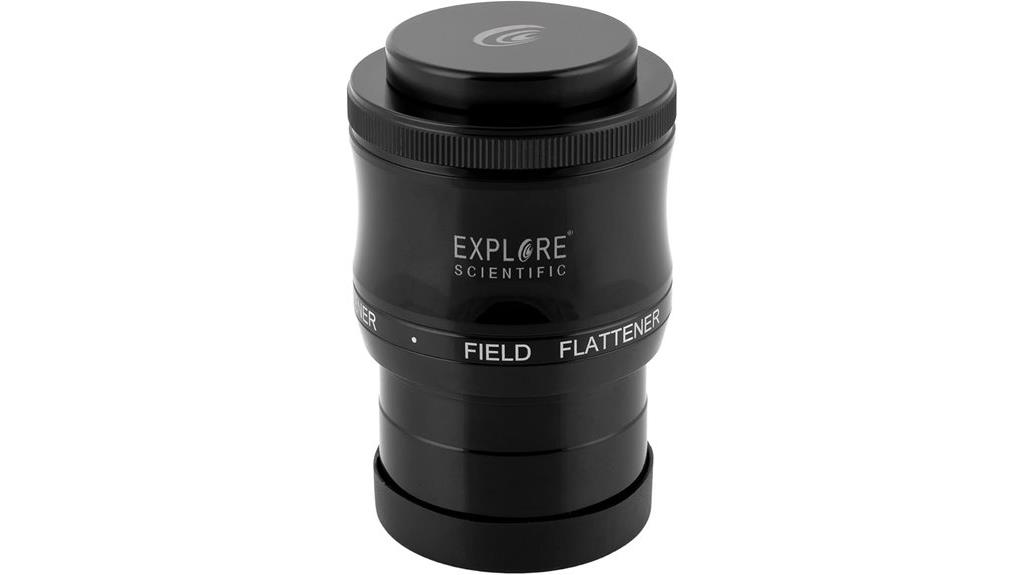
If you’re aiming to capture crisp, distortion-free images of celestial objects, the Explore Scientific Field Flattener is an excellent choice for refractor telescope users. It effectively minimizes star distortion caused by field curvature, especially toward the edges of your images. Designed for telescopes with focal ratios between f/5 and f/7, it requires a precise 55mm (+/- 2mm) spacing between the device and your camera sensor for best results. With a T-ring thread for easy attachment and fully multi-coated optical glass, it enhances light transmission, contrast, and overall image quality. This flattener produces high-contrast, sharp astrophotos of planets, nebulae, galaxies, and star clusters.
Best For: amateur and professional astrophotographers using refractor telescopes with focal ratios between f/5 and f/7 seeking to improve image sharpness and minimize star distortion in their celestial imaging.
Pros:
- Effectively reduces star distortion caused by field curvature for sharper edge-to-edge images
- Fully multi-coated optical glass enhances light transmission and image contrast
- Easy to attach via T-ring thread, compatible with various cameras and telescopes
Cons:
- Requires precise 55mm (+/- 2mm) spacing for optimal performance, which may need careful adjustment
- Designed specifically for telescopes with focal ratios of f/5 to f/7, limiting use with other focal ratios
- May be less effective if not properly aligned or if spacing is not accurately maintained
SVBONY SV503 Refractor Telescope with Camera
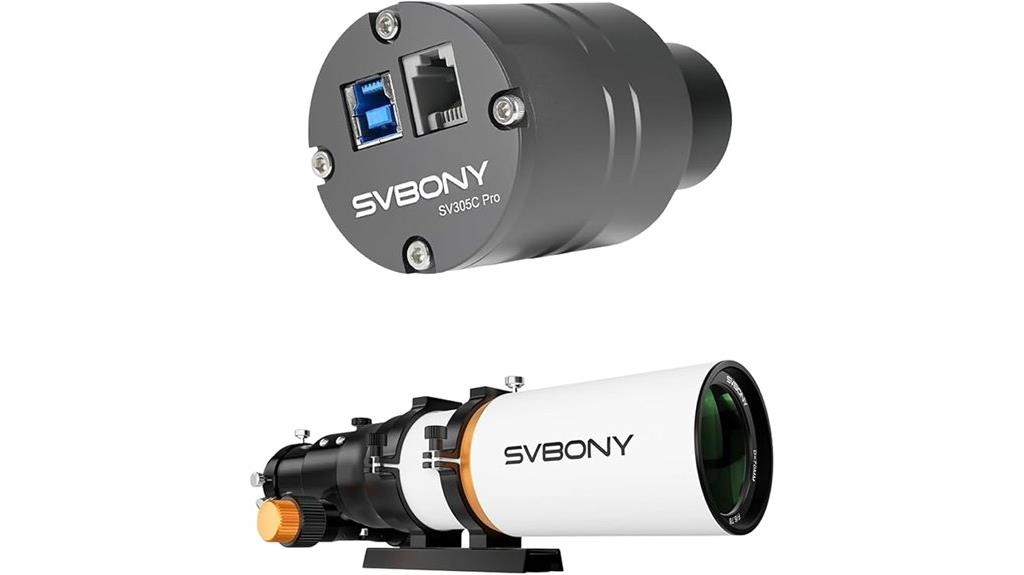
The SVBONY SV503 Refractor Telescope with Camera stands out as an excellent choice for amateur astronomers seeking high-quality planetary and deep-sky imaging. Its built-in field flattener ensures wide, flat views, eliminating field curvature and distortion at the edges. The F/6.78 aperture with 70mm diameter captures bright, sharp images of galaxies, nebulae, and star clusters with true-to-life colors, thanks to ED glass and flat-field design. The IMX662 camera provides ultra-high sensitivity, low noise, and fast frame rates, delivering detailed planetary images even in low light. This integrated system offers outstanding clarity, making it ideal for enthusiasts aiming for crisp, edge-to-edge astrophotos.
Best For: amateur astronomers and astrophotography enthusiasts seeking high-quality planetary and deep-sky imaging with wide, flat views and true-to-life colors.
Pros:
- Built-in field flattener ensures distortion-free, wide, flat images across the entire field of view
- Equipped with IMX662 camera for ultra-high sensitivity, low noise, and fast frame rates for detailed planetary imaging
- Ed glass and flat-field design provide accurate colors and high image fidelity with minimal chromatic aberration
Cons:
- Limited aperture size of 70mm may restrict deep-sky object brightness for some users
- Requires some familiarity with astrophotography equipment and setup for optimal results
- May be less suitable for advanced astrophotographers seeking larger apertures or more customizable features
Astromania 2″ Field Flattener for Astronomy Photos
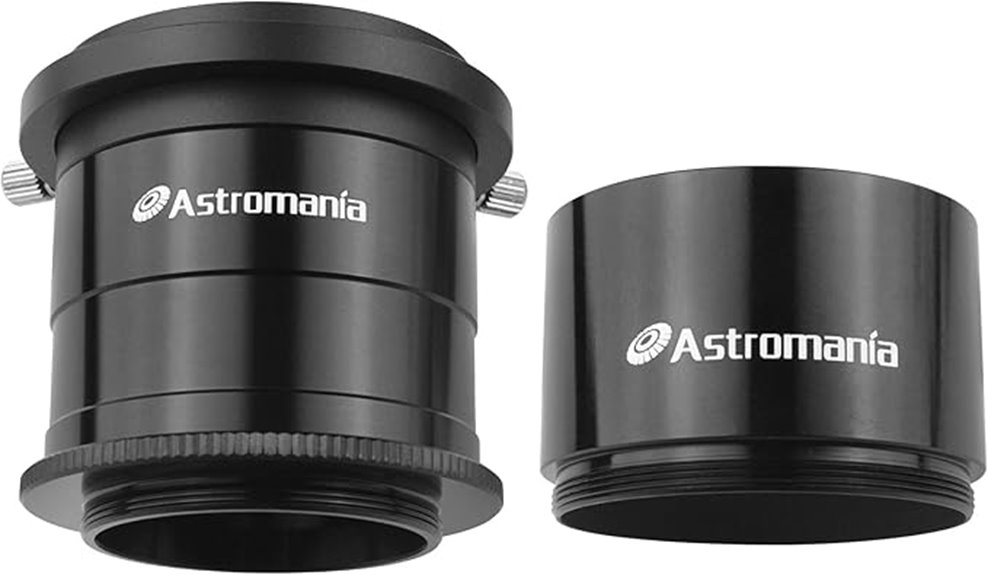
For those using refractor telescopes with focal ratios from f/4 to f/8, the Astromania 2″ Field Flattener offers an excellent solution to achieve sharp, flat images across the entire field. It features M48 threading for full aperture illumination at 2 inches and fits accessories within 109mm back focus. Designed to correct field curvature, it produces pinpoint stars from center to edge, boosting astrophotography quality. Its high-quality multi-coated lenses ensure minimal aberrations and maximum light transmission. Compact and lightweight at just over 6 ounces, it’s easy to handle and install. Overall, it provides reliable, edge-to-edge sharpness, making it a great choice for capturing detailed astrophotos.
Best For: astrophotographers using refractor telescopes with focal ratios between f/4 and f/8 seeking sharp, flat images across the entire field.
Pros:
- Corrects field curvature for pinpoint stars from center to edge
- High-quality multi-coated lenses for optimal light transmission and minimal aberrations
- Compact and lightweight design for easy handling and installation
Cons:
- Only compatible with refractors within specified focal ratios
- Slightly limited back focus (109mm), which may restrict some accessory configurations
- Customer ratings average 3.8 stars, indicating mixed reviews on long-term performance
SVBONY SV503 Portable Telescope Tube, 70ED F6 Optical Tube

Designed for portability and high optical performance, the SVBONY SV503 Portable Telescope Tube with a 70ED F6 optical design is an excellent choice for both serious astronomers and passionate beginners. Its objective lens uses S-FPL51 ED glass, virtually eliminating chromatic aberration and delivering sharp, high-contrast images ideal for detailed observation and astrophotography. The 70ED F6 tube is durable and lightweight, making it perfect for travel. Equipped with a precise 2-inch rack and pinion focuser, it supports heavy accessories and offers smooth focusing. Whether you’re eyeing planets, nebulae, or terrestrial objects, this telescope promises authentic imaging, portability, and versatile use.
Best For: both experienced astronomers and passionate beginners seeking portable, high-quality optical performance for astrophotography and terrestrial observation.
Pros:
- Features S-FPL51 ED glass to virtually eliminate chromatic aberration for sharp, high-contrast images.
- Durable, lightweight 70ED F6 optical tube ideal for travel and mobile use.
- Equipped with a precise 2-inch rack and pinion focuser supporting heavy accessories for stable imaging.
Cons:
- May require additional accessories such as mounts or adapters for complete setup.
- As a portable tube, it lacks built-in mounts or tripods included.
- Optical performance highly dependent on proper collimation and setup by the user.
SVBONY SV503 Refractor Telescope, 102mm F7

If you’re looking to capture sharp, distortion-free images with your refractor telescope, the SVBONY SV503 102mm F7 stands out thanks to its high-quality optical design. Its 102mm aperture and 714mm focal length deliver bright, detailed images suitable for planetary and deep-sky viewing. The doublet air-spaced achromatic S-FPL51 ED glass reduces chromatic aberration, ensuring accurate colors. Fully Multi-Coated lenses maximize light transmission, boosting contrast and brightness. The dual-speed focuser and 360° Field Rotator allow precise framing and focus adjustments. With a retractable lens hood and all-encompassing accessories, the SV503 is a versatile, reliable choice for both astrophotography and terrestrial observations.
Best For: amateur astronomers and astrophotographers seeking a versatile, high-quality refractor telescope for planetary and deep-sky imaging and observation.
Pros:
- High-quality 102mm aperture and 714mm focal length deliver bright, detailed images.
- Doublet air-spaced achromatic S-FPL51 ED glass reduces chromatic aberration for sharper, more accurate colors.
- Fully Multi-Coated lenses and 360° Field Rotator facilitate precise framing, enhanced contrast, and seamless imaging adjustments.
Cons:
- May require additional accessories for advanced astrophotography setups.
- Slightly heavier design might be less portable for field use.
- Not suitable for very large deep-sky objects without additional mounting or support equipment.
SVBONY SV193 Focal Reducer 2 Inch 0.8X for Telescope Camera
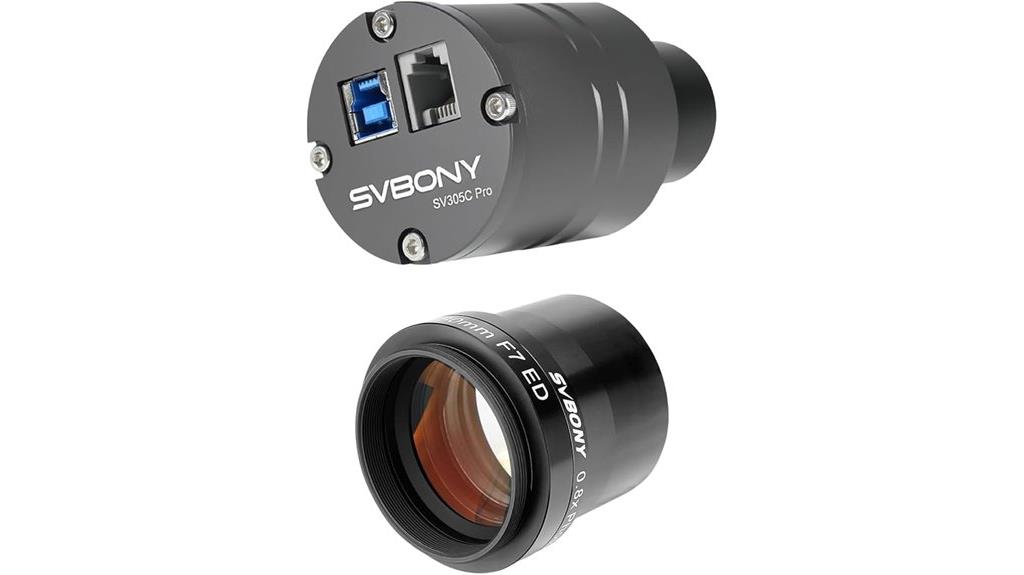
The SVBONY SV193 Focal Reducer 2 Inch 0.8X stands out as an excellent choice for astrophotographers seeking sharp, distortion-free images across the entire field of view. Designed for refractor telescopes, it reduces focal length and flattens the field, ensuring crisp details from center to edge. Compatible with full-frame cameras, including IMX662 planetary models, it offers high sensitivity and low noise for capturing fine planetary features. Its 2-inch front socket and M48x0.75 threading make setup straightforward. With excellent edge correction and fast imaging capabilities, this focal reducer is ideal for both planetary and deep-sky astrophotography, delivering consistently sharp images.
Best For: astrophotographers seeking to capture sharp, distortion-free planetary and deep-sky images with full-frame cameras using refractor telescopes.
Pros:
- Reduces focal length and flattens the field for clearer, distortion-free images across the entire frame
- Compatible with full-frame cameras, including high-sensitivity planetary models like IMX662
- Features ultra-high sensitivity with low noise (0.7e readout noise) and high frame rate capability for fast, sharp planetary imaging
Cons:
- Designed specifically for refractor telescopes, limiting compatibility with other telescope types
- Requires M48x0.75 threading, which may necessitate adapters for some setups
- May involve additional accessories or adjustments for optimal performance in different configurations
Astromania 2″ Field Flattener for Astronomy Photos
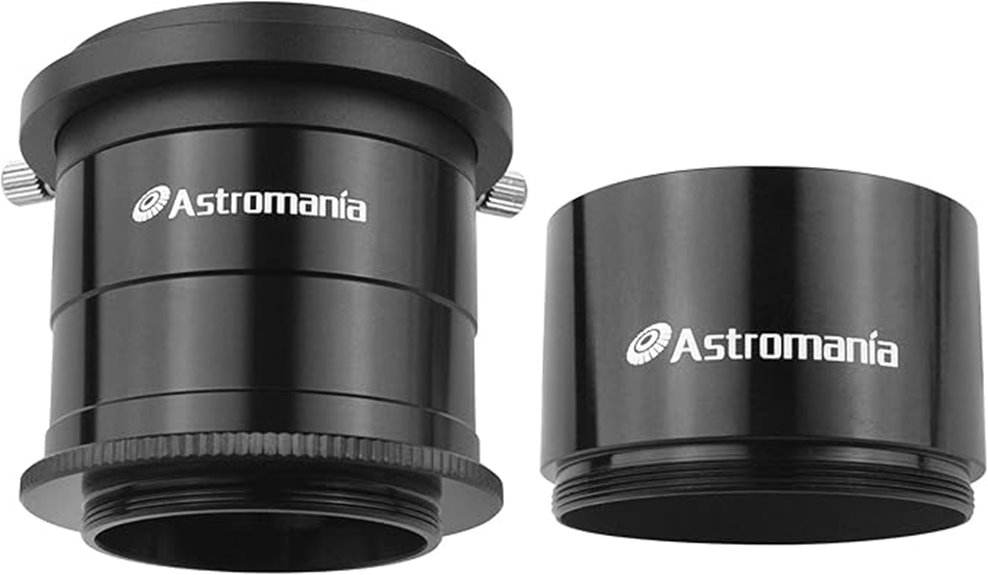
For astrophotographers seeking consistent, sharp images across their entire field of view, the Astromania 2″ Field Flattener stands out as a reliable choice. It guarantees perfect image flatness, producing pin-point stars from center to edge. Compatible with refractors from f/4 to f/8 and M48 threading, it offers about 109mm of back focus for versatile setups. Its multi-coated lenses minimize reflections, boosting clarity and contrast. Designed specifically for astrophotography, it reduces field curvature and distortions, resulting in high-quality, detailed images with minimal post-processing. This flattener provides a professional-grade solution to achieve crisp, edge-to-edge images effortlessly.
Best For: astrophotographers using refractor telescopes from f/4 to f/8 who want sharp, flat-field images with minimal post-processing.
Pros:
- Produces perfect image flatness with sharp, pin-point stars across the entire field
- Compatible with M48 threaded refractors and offers approximately 109mm of back focus
- Multi-coated lenses reduce reflections, enhancing clarity, contrast, and brightness
Cons:
- Designed primarily for astrophotography and visual observing, limiting its use for other applications
- May require precise setup to ensure optimal performance and image quality
- Compatibility is limited to telescopes with M48 threading, which may not suit all models
SVBONY SV220 Dual-Band Nebula Filter with SV503 70mm Refractor Telescope
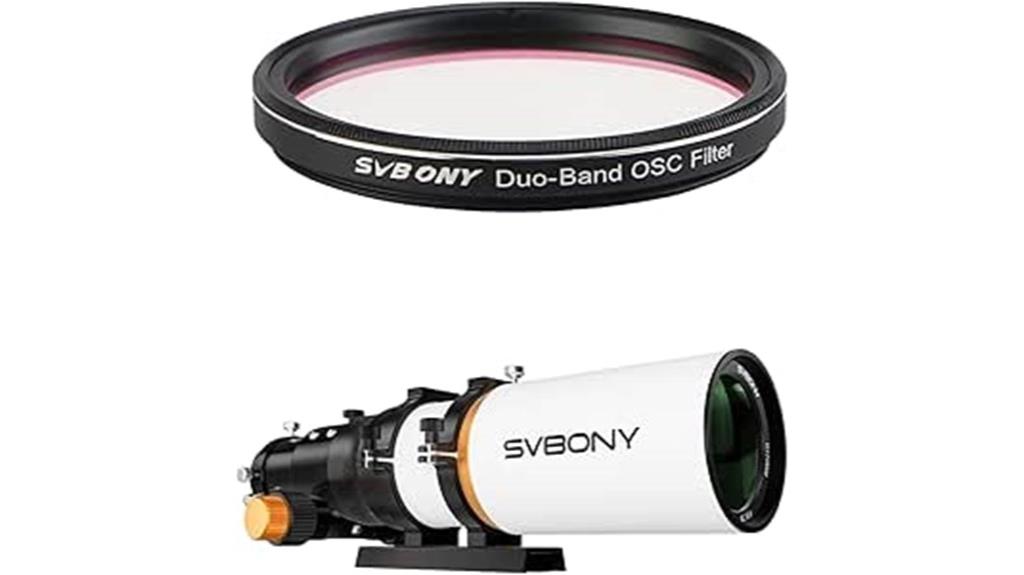
Featuring the SVBONY SV220 Dual-Band Nebula Filter paired with the SV503 70mm Refractor Telescope offers an ideal setup for amateur astronomers seeking to enhance nebula viewing and astrophotography. The telescope’s F/6.78 aperture delivers bright, sharp images of galaxies, nebulae, and star clusters, while the built-in field flattener guarantees wide, distortion-free views with minimal chromatic aberration. The dual-band filter reduces light pollution from sources like moonlight and streetlights, boosting contrast and brightness of gaseous nebulae. This combination allows for detailed, high-contrast imaging even in light-polluted areas, making it perfect for both visual observation and astrophotography.
Best For: amateur astronomers and astrophotographers seeking to enhance nebula and deep-sky object observation and imaging in various sky conditions, including light-polluted areas.
Pros:
- Provides bright, sharp, and true-to-life images of celestial objects with minimal chromatic aberration.
- Effectively reduces light pollution, enhancing contrast and visibility of gaseous nebulae.
- Suitable for both visual observation and astrophotography, offering high-contrast imaging capabilities.
Cons:
- May require additional accessories or mounts for optimal use during astrophotography sessions.
- The filter’s effectiveness can vary depending on local light pollution levels and atmospheric conditions.
- The setup might be less effective for very faint or distant objects compared to larger telescopes.
SVBONY SV193 Focal Reducer for SV503 Telescope

If you own a SV503 80mm F7 ED refractor telescope and want sharper, more efficient astrophotography, the SVBONY SV193 Focal Reducer is an excellent choice. This 2-inch, 0.8x focal reducer not only shortens exposure times but also reduces star point distortion at the edges, resulting in crisp, detailed images across the entire frame. It features a field flattener function that corrects image curvature, ensuring consistent sharpness from center to edge. With a standard 2-inch socket and M48 threading for camera connection, it supports full-frame sensors and filters. This accessory streamlines your imaging setup and enhances overall celestial photo quality.
Best For: astrophotographers using SV503 80mm F7 ED refractor telescopes who want to improve image sharpness, reduce exposure time, and achieve high-quality celestial photos.
Pros:
- Shortens exposure times, increasing imaging efficiency
- Effectively reduces star point distortion at the frame edges
- Supports full-frame cameras and accommodates 2-inch filters for versatile use
Cons:
- Designed specifically for SV503 80mm F7 ED models, limiting compatibility with other telescopes
- Requires proper thread alignment for optimal attachment
- May add complexity to the imaging setup for beginners unfamiliar with focal reducers
SVBONY SV260 2″ Telescope Filter

The SVBONY SV260 2″ Telescope Filter stands out as an excellent choice for astrophotographers seeking to enhance their deep-sky imaging. Its multi-bandpass design effectively isolates light pollution while maintaining over 90% transmittance, allowing more light from celestial objects to reach the sensor. The filter’s OD4 cut-off depth guarantees strong light pollution suppression without sacrificing detail. Built to work seamlessly with the SV503 refractor, it preserves true-to-life colors and reduces chromatic aberration. This results in sharper, more vibrant images of galaxies, nebulae, and star clusters, making it an invaluable tool for capturing high-quality astrophotography through refractors.
Best For: astrophotographers and amateur astronomers aiming to capture detailed, vibrant deep-sky images with minimal light pollution interference using a 2-inch refractor setup.
Pros:
- Over 90% peak transmittance ensures bright, clear celestial images.
- Effectively isolates multiple light pollution wavelengths, enhancing image contrast.
- Compatible with SV503 refractor telescopes, reducing chromatic aberration and maintaining true colors.
Cons:
- May be more expensive than standard single-band filters.
- Requires a 2-inch compatible focuser or filter holder.
- Not suitable for visual observation as it is optimized for astrophotography.
Factors to Consider When Choosing Field Flatteners for Refractor Telescopes

When selecting a field flattener, I consider how well it fits my telescope’s compatibility and whether it offers the desired field of view expansion. I also evaluate its optical quality, coatings, and how much it reduces focal length to meet my imaging needs. Finally, ease of installation and overall build quality are key factors to guarantee a smooth setup and reliable performance.
Compatibility With Telescope
Choosing a compatible field flattener requires careful attention to your refractor telescope’s specifications. First, verify the flattener is designed for your telescope’s focal ratio, typically between f/4 and f/8, to achieve ideal results. Check that the thread size and connection type, such as M48, M56, or 2-inch, match your focuser and accessories to avoid fit issues. It’s also important to confirm compatibility with your telescope’s aperture and optical design to prevent vignetting or star distortion at the edges. Additionally, confirm that the flattener supports your camera type and size, especially if you’re using a full-frame sensor. Finally, review manufacturer guidelines for the recommended back focus distance to maintain proper focus and image quality.
Field of View Expansion
Selecting a field flattener involves more than just matching it to your telescope’s specifications; it directly impacts how much of the sky you can capture in a single shot. A good flattener corrects optical distortions, expanding the usable field of view and allowing you to include larger celestial objects like nebulae and star clusters without vignetting or edge distortion. It also guarantees the entire image remains sharp from center to edge, which is vital for detailed astrophotography. By aligning the telescope’s focal plane with your camera sensor, a proper flattener maximizes your true field of view. This means you get wider, more inclusive images without cropping or extensive post-processing, making your astrophotography sessions more efficient and rewarding.
Optical Quality and Coatings
Optical quality and coatings play a crucial role in ensuring your field flattener delivers sharp, clear images across the entire field of view. High-quality flatteners use multi-coated optical glass to maximize light transmission and reduce reflections, which enhances image brightness and contrast. Superior coatings also help minimize chromatic aberration and ghosting, resulting in more accurate, crisp images. Additionally, multi-coating boosts contrast and brightness, especially at the edges, providing a uniform viewing experience. These coatings are designed to withstand environmental factors like moisture and dust, ensuring durability over time. Proper application of lens coatings minimizes light loss, maintaining high image fidelity, essential for astrophotography and detailed observations. Investing in well-coated, high-quality optics guarantees consistent, edge-to-edge clarity in your images.
Focal Length Reduction
Focal length reduction is a key factor to weigh when adding a field flattener to your refractor telescope. Typically, flatteners decrease the focal length by about 0.8x to 0.9x, resulting in a wider field of view. This reduction allows for shorter exposure times and more efficient imaging, especially in astrophotography. By lowering the effective focal ratio—say from f/7 to around f/5.6—you make your telescope faster and better suited for capturing larger celestial objects. The extent of the focal length reduction directly influences the field of view, with more significant reductions providing broader coverage. Properly matching the reduction to your telescope’s focal ratio is essential for achieving sharp, edge-to-edge images and minimizing optical aberrations.
Ease of Installation
When choosing a field flattener for your refractor telescope, ease of installation should be a top consideration. You want a device with compatible threading or attachment mechanisms that fit your focuser or camera adapter easily. The installation process should be straightforward, ideally requiring minimal tools or adjustments, so you can set it up quickly without frustration. Clear, detailed instructions or diagrams are essential to guarantee proper setup and alignment, saving you time and effort. Additionally, consider whether the design allows easy access for focus adjustments after installation, which helps maintain image quality. Finally, check that the flattener’s weight and size won’t throw off your telescope’s balance or mounting stability, ensuring smooth operation during your observing sessions.
Frequently Asked Questions
How Do Field Flatteners Affect Exposure Times in Astrophotography?
Field flatteners don’t directly affect exposure times, but they improve image quality by reducing edge distortion, allowing me to capture sharper, more detailed astrophotographs in less time. With better correction, I don’t need to take multiple images or adjust settings as often, which streamlines my workflow. Ultimately, using a field flattener helps me get clear, crisp images faster, making my astrophotography sessions more efficient and enjoyable.
Are Field Flatteners Compatible With All Refractor Telescope Brands?
Absolutely, not all field flatteners are compatible with every refractor telescope brand. Some are designed specifically for certain models, while others are more versatile. I’ve found that checking the manufacturer’s specifications is essential before buying. It’s like finding the perfect puzzle piece—if it doesn’t fit, your images suffer. So, always verify compatibility to guarantee your telescope delivers those crisp, stunning, edge-to-edge images you’re dreaming of!
What Maintenance Is Required for Field Flatteners Over Time?
Maintaining your field flattener is straightforward. I regularly clean the lens elements with a soft brush or cloth to remove dust and fingerprints. I also check for any misalignment or scratches that could affect image quality. Periodically, I make sure all mounting hardware is secure. If I notice any deterioration, I replace or professionally service the flattener to keep my images crisp and edge-to-edge sharp.
Can Field Flatteners Improve Image Quality for Planetary Imaging?
Imagine a painter smoothing out wrinkles on a canvas—that’s what a field flattener does for planetary images. Yes, it can considerably improve quality by reducing distortions and ensuring sharpness across the entire field. This leads to crisper details, especially at the edges. So, if you want your planetary shots to look more like a polished masterpiece, a good field flattener is an invaluable tool.
How Do I Determine the Right Flattener for My Specific Telescope Model?
To find the right flattener for my telescope, I first check my telescope’s make and model, then consult the manufacturer’s recommendations. I review compatibility details and look for flatteners designed specifically for my optical system. I also read user reviews and ask fellow astronomers for advice. Guaranteeing the flattener matches my telescope ensures I get crisp, edge-to-edge images without distortions.
Conclusion
Choosing the right field flattener truly feels like finding the missing piece of a cosmic puzzle. With so many options, I see it’s about balancing clarity, compatibility, and quality—much like how astronomers once sought celestial harmony. When you pick wisely, your images will be as crisp and breathtaking as the stars themselves. Remember, the right tool transforms a good view into a window to the universe’s finest details.
